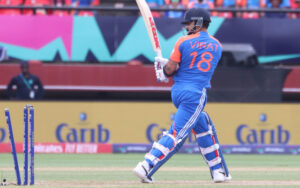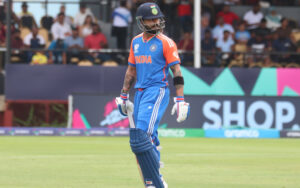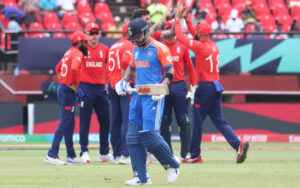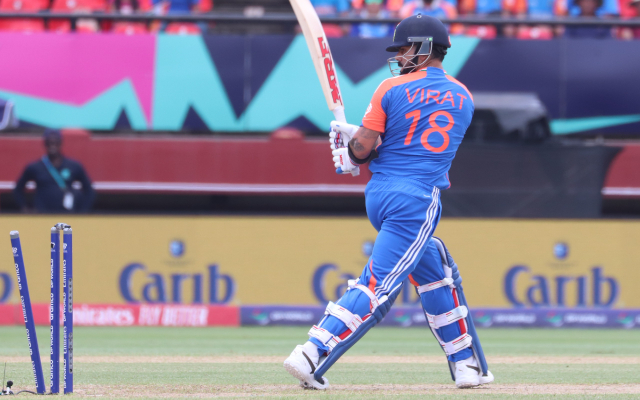
Maybe, there’s an irony in Virat Kohli’s current travails. A few years ago, when he was the India captain, ‘intent’ ruled team talks, especially in Test cricket. It forced Cheteshwar Pujara to change his natural game and he struggled, eventually losing his place in the team. A grafter was told to become an enforcer at No. 3, but that was not Pujara’s game.
Another single-digit – nine off as many balls – score against England took Kohli’s tournament tally at the ongoing T20 World Cup to 75 runs in seven matches at an average of 10.71. He tried a heave across the line to a length ball from Reece Topley that shaped back a bit. He missed it and was out bowled. Slogging was never his game.
Like Pujara in Tests, Kohli’s T20I batting has become a victim of India’s changed philosophy of showing unadulterated aggression top-down in the shortest format. He always liked to bat at his own pace, a method that gave him stupendous success. Now, suddenly asked to change it in a tournament where the majority of the pitches have had enough assistance for the seam bowlers upfront, Kohli has found himself in a tricky situation. He is trying his best, but it’s not working. Unfortunately, he is not getting the rub of the green either.
For the Latest Sports News: Click Here

On the eve of the semi-final, when Rohit Sharma was asked about Kohli’s form at the pre-match press conference, the skipper’s advice was to feel comfortable about what a batsman has been doing. “I felt good last game (against Australia), it might work for someone else,” said Rohit. Something, though, remained unanswered; why did the Indian team management decide to sacrifice their best white-ball batsman in tough batting conditions?
Kohli is arguably the best-ever No. 3 in white-ball cricket. He has scored almost all his runs batting in that position. His T20I average before this tournament was north of 50. It has now come down to 48.84. Yes, Kohli was in scintillating form as a Royal Challengers Bengaluru opener in this year’s IPL, scoring more than 700 runs and winning the Orange Cap. But the IPL was played on highway-like pitches. Also, and more importantly, international cricket is a different ball game. The decision to open with Kohli, when the team has a specialist opener of Yashasvi Jaiswal’s calibre, was a mistake. It hasn’t come back to haunt India, because collectively the batting unit made up for Kohli’s lack of runs. But it has badly affected Kohli’s form.
Nothing succeeds like success, and India’s winning run has given the team management the ‘excuse’ to retain a winning combination. But Jaiswal at the top and Kohli at No. 3 would have made the team’s batting meatier. It would have allowed a left-right combination at the top as well. The logic of not playing Jaiswal to accommodate Shivam Dube in the middle order doesn’t hold water either. Suryakumar Yadav or Rishabh Pant at No. 5 would have been a far better option, because they are better players than the Mumbai all-rounder.
Dube was picked ahead of Rinku Singh in the 15-member squad because of his ability to hit the spinners in the middle overs. In the semi-final though, Hardik Pandya was sent ahead of him, when Adil Rashid and Liam Livingstone were bowling in tandem. Dube walked in at No. 7, and he returned after a first-ball duck. As for his bowling, the team management seemingly doesn’t trust it.

Only last week, India coach Rahul Dravid had spoken about the importance of being flexible. The team management, however, has proved to be rigid with regard to Kohli’s batting position. There’s no steadfast rule that a winning combination cannot be broken. For example, Sunrisers Hyderabad did it in the 2016 IPL final, bringing in Ben Cutting almost out of nowhere. Cutting’s 39 not out off 15 balls made the difference, as SRH beat RCB.
Before that, in the 2012 IPL final, then Kolkata Knight Riders captain Gautam Gambhir decided to play Manvinder Bisla at the expense of Brendon McCullum. Bisla’s 48-ball 89 won KKR the match. The two winning teams chose horses for courses.
India beat England to reach the final and are now the favourites to win the cup. Yet, it must be said that the team’s experiment with Kohli as an opener has failed. And unless the former India captain regains his mojo and plays a special knock in the final, it might even impact his T20I future.
Also Read: Axar Patel – From Support Cast to Star Turn





